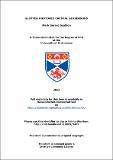Files in this item
Slotted photonic crystal biosensors
Item metadata
| dc.contributor.author | Scullion, Mark Gerard | |
| dc.coverage.spatial | 132 | en_US |
| dc.date.accessioned | 2013-03-20T15:20:35Z | |
| dc.date.available | 2013-03-20T15:20:35Z | |
| dc.date.issued | 2013-06-26 | |
| dc.identifier.uri | https://hdl.handle.net/10023/3405 | |
| dc.description.abstract | Optical biosensors are increasingly being considered for lab-on-a-chip applications due to their benefits such as small size, biocompatibility, passive behaviour and lack of the need for fluorescent labels. The light guiding mechanisms used by many of them result in poor overlap of the optical field with the target molecules, reducing the maximum sensitivity achievable. This thesis presents a new platform for optical biosensors, namely slotted photonic crystals, which engender higher sensitivities due to their ability to confine, spatially and temporally, the peak of optical mode within the analyte itself. Loss measurements showed values comparable to standard photonic crystals, confirming their ability to be used in real devices. A novel resonant coupler was designed, simulated, and experimentally tested, and was found to perform better than other solutions within the literature. Combining with cavities, microfluidics and biological functionalization allowed proof-of-principle demonstrations of protein binding to be carried out. High sensitivities were observed in smaller structures than most competing devices in the literature. Initial tests with cellular material for real applications was also performed, and shown to be of promise. In addition, groundwork to make an integrated device that includes the spectrometer function was also carried out showing that slotted photonic crystals themselves can be used for on-chip wavelength specific filtering and spectroscopy, whilst gas-free microvalves for automation were also developed. This body of work presents slotted photonic crystals as a realistic platform for complete on-chip biosensing; addressing key design, performance and application issues, whilst also opening up exciting new ideas for future study. | en_US |
| dc.language.iso | en | en_US |
| dc.publisher | University of St Andrews | |
| dc.rights | Creative Commons Attribution-NonCommercial-NoDerivs 3.0 Unported | |
| dc.rights.uri | http://creativecommons.org/licenses/by-nc-nd/3.0/ | |
| dc.subject | Photonic crystals | en_US |
| dc.subject | Optical biosensors | en_US |
| dc.subject | Microfluidics | en_US |
| dc.subject | Slot waveguides | en_US |
| dc.subject | Lab on a chip | en_US |
| dc.subject.lcc | R857.B54S3 | |
| dc.subject.lcsh | Photonic crystals | en_US |
| dc.subject.lcsh | Biosensors | en_US |
| dc.subject.lcsh | Microfluidics | en_US |
| dc.subject.lcsh | Optical wave guides | en_US |
| dc.subject.lcsh | Miniature electronic equipment | en_US |
| dc.title | Slotted photonic crystal biosensors | en_US |
| dc.type | Thesis | en_US |
| dc.type.qualificationlevel | Doctoral | en_US |
| dc.type.qualificationname | PhD Doctor of Philosophy | en_US |
| dc.publisher.institution | The University of St Andrews | en_US |
This item appears in the following Collection(s)
Except where otherwise noted within the work, this item's licence for re-use is described as Creative Commons Attribution-NonCommercial-NoDerivs 3.0 Unported
Items in the St Andrews Research Repository are protected by copyright, with all rights reserved, unless otherwise indicated.


